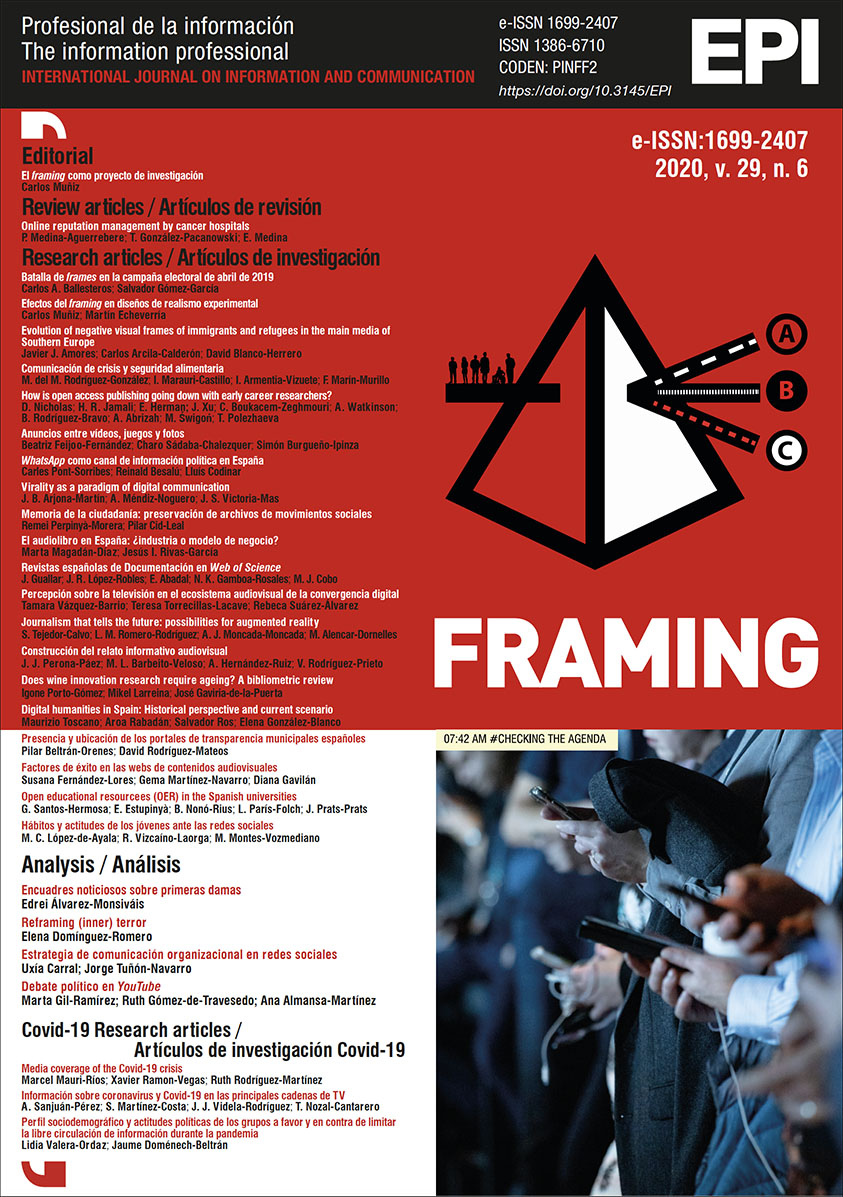Coronavirus and Covid-19 information in the main Spanish TV channels before the confinement period
DOI:
https://doi.org/10.3145/epi.2020.nov.11Keywords:
Covid-19, Coronavirus, SARS-CoV-2, Pandemics, Health information, Television, DTT, Agenda-setting, Framing, Google Trends, Spain, Italy, ChinaAbstract
The evolution of content on the coronavirus epidemic in the 24 hours of free-to-air Spanish television is analyzed in the months before the declaration of a state of alarm, when China and Italy were the countries with the greatest number of infections. We observed the presence of terms related to the pandemic, identifying the kind of information transmitted since the coronavirus disease began, in all broadcasts from La 1, Antena 3, Tele 5, and La sexta channels. The data were taken on alternate days (Tuesdays, Thursdays, and Saturdays), with a total review of 31 days, ranging from 1 January to 13 March 2020, when confinement began throughout Spain. This information was compared with the results of general searches and news searches made by Spanish users, to check whether the data were different or ran in parallel with the television data. The conversation about the coronavirus on television clearly changed during the week when confinement was introduced in some areas of Italy. This indicates that the consequences of the pandemic were not anticipated until its effects were already visible. The results also indicate that there was hardly any significant variation in the focus of the programs broadcast by each of the channels.
Downloads
References
ABC (2020). "El alarmismo sobre el coronavirus vende en televisión". ABC play, 27 febrero. https://www.abc.es/play/cine/noticias/abci-alarmismo-sobre-coronavirus-vende-television-202002261342_noticia.html
Ali, Khudejah; Zain-ul-abdin, Khawaja; Li, Cong; Johns, Lisa; Ali, Ayesha-Aziz; Carcioppolo, Nicholas (2019). "Viruses going viral: Impact of fear-arousing sensationalist social media messages on user engagement". Science communication, v. 41, n. 3, pp. 314-338. https://doi.org/10.1177/1075547019846124
Casero-Ripollés, Andreu (2020). "Impact of Covid-19 on the media system. Communicative and democratic consequences of news consumption during the outbreak". El profesional de la información, v. 29, n. 2, e290223. https://doi.org/10.3145/epi.2020.mar.23
Doan, Alexi (2019). "Epidemiology of fear: investigating societal responses to pathogenic invasión". The iScientist, v. 4, n. 1, pp. 15-25. https://journals.mcmaster.ca/iScientist/article/view/1929
Europa Press (2020). "El juez empieza a investigar el "˜Delcygate´ y pide información a Interior". La vanguardia, 27 febrero. https://www.lavanguardia.com/politica/20200227/473810491078/juez-delcygate-investigar-jose-luis-abalos-informacion-ministerio-de-interior.html
Goffman, Erving (2006). Frame analysis. Los marcos de la experiencia (1ª ed.). Madrid: Centro de Investigaciones Sociológicas (CIS), Siglo XXI Editores. ISBN: 978 84 74764116
Ingenhoff, Diana; Segev, Elad; Chariatte, Jérí´me (2020). "The construction of country images and stereotypes: From public views to Google searches". International journal of communication v. 14, pp. 92-113. https://ijoc.org/index.php/ijoc/article/view/10799
McCombs, Maxwell E.; Shaw, Donald L. (1972). "The agenda setting function of mass media". Public opinion quarterly, v. 36, n. 2, pp. 176-187. https://doi.org/10.1086/267990
Medeiros, Flavia-Natércia-Da-Silva; Massarani, Luisa (2010) "Pandemic on the air: a case study on the coverage of new influenza A/H1N1 by Brazilian prime time TV news". Journal of science communication, v. 9, n. 3, A03. https://doi.org/10.22323/2.09030203
Morgan, Michael; Shanahan, James (2010). "The state of cultivation". Journal of broadcasting & electronic media, v. 54, n. 2, pp. 337-355. https://doi.org/10.1080/08838151003735018
Navarro-Moreno, José-Antonio; Olmo-López, Agustín (2018). "Presencia política en Televisión Española en los últimos procesos electorales". Estudios sobre el mensaje periodístico, v. 24, n. 2, pp. 1473-1488. https://doi.org/10.5209/ESMP.62229
Rodríguez-Wangí¼emert, Carmen; Rodríguez-Breijo, Vanessa; Pestano-Rodríguez, José-Manuel (2019). "The framing of China on Spanish television". Communication & society, v. 32, n. 3, pp. 123-138. https://doi.org/10.15581/003.32.3.123-137
Rosenberg, Charles E. (1989). "What is an epidemic? AIDS in historical perspective". Daedalus, v. 118, n. 2, pp. 1-17. https://www.jstor.org/stable/20025233
RTVE (2020). "El video de Lorenzo Milá que normaliza el coronavirus: "˜Se extiende más el alarmismo que los datos´". RTVE, 25 febrero. https://www.rtve.es/noticias/20200225/lorenzo-mila-tve-desde-italia-hablando-del-coronavirus-se-extiende-mas-alarmismo-datos/2004471.shtml
Scheufele, Dietram (1999). "Framing as a theory of media effects". Journal of communication, v. 49, n. 1, pp. 103-122. https://doi.org/10.1111/j.1460-2466.1999.tb02784.x
Segev, Elad (2018). "Googling the world: Global and regional information flows in Google Trends". International journal of communication, v. 12, pp. 2232-2250. https://ijoc.org/index.php/ijoc/article/view/7947
Strong, Philip (1990) "Epidemic psychology: A model". Sociology of health and illness, v. 12, n. 3, pp.249-259. https://doi.org/10.1111/1467-9566.ep11347150
Xifra, Jordi (2020). "Comunicación corporativa, relaciones públicas y gestión del riesgo reputacional en tiempos del Covid-19". El profesional de la información, v. 29, n. 2, e290220. https://doi.org/10.3145/epi.2020.mar.20
Downloads
Published
How to Cite
Issue
Section
License
Dissemination conditions of the articles once they are published
Authors can freely disseminate their articles on websites, social networks and repositories
However, the following conditions must be respected:
- Only the editorial version should be made public. Please do not publish preprints, postprints or proofs.
- Along with this copy, a specific mention of the publication in which the text has appeared must be included, also adding a clickable link to the URL: http://www.profesionaldelainformacion.com
- Only the final editorial version should be made public. Please do not publish preprints, postprints or proofs.
- Along with that copy, a specific mention of the publication in which the text has appeared must be included, also adding a clickable link to the URL: http://revista.profesionaldelainformacion.com
Profesional de la información journal offers the articles in open access with a Creative Commons BY license.




